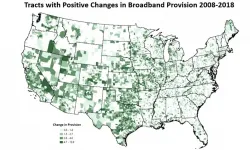Research uncovers broadband gaps in US to help close digital divide
2021-06-10
(Press-News.org) High-speed internet access has gone from an amenity to a necessity for working and learning from home, and the COVID-19 pandemic has more clearly revealed the disadvantages for American households that lack a broadband connection.
To tackle this problem, Michigan State University researchers have developed a new tool to smooth the collection of federal broadband access data that helps pinpoint coverage gaps across the U.S. The research was published May 26 In the journal PLOS ONE.
"Nearly 21% of students in urban areas are without at-home broadband, while 25% and 37% lack at-home broadband in suburban and rural areas," said Elizabeth A. Mack, associate professor in the Department of Geography, Environment, and Spatial Sciences in the College of Social Science.
"As more of our day-to-day activities continue to move online, including education, commerce and health care, it's essential that we understand where gaps in digital infrastructure exist. This is especially important if we want to address disparities in access related to demographics, socioeconomic status, and educational attainment," she said.
When the U.S. Congress first passed the Telecommunications Act of 1996, the goal was to encourage competition in the telecommunications industry while improving the quality of service and lowering customer prices. To determine the act's effectiveness, the Federal Communications Commission created a standardized form (Form 477) where twice a year, internet service providers are required to report where they provide service to residential and business customers.
"To date, Form 477 data remains the best publicly available data source regarding broadband deployment," said Scott Loveridge, a professor in the Department of Agricultural, Food, and Resource Economics (AFRE). "Unfortunately, there are a lot of nuances to these data which to this point have prevented us from conducting useful analyses over time."
One of these nuances is that the data collected from 2008 to 2018 spans the two census reporting periods of 2000 and 2010. This has made it difficult to look at the data overall and align it with the shifting census geographies, which do change each census year.
Loveridge, Mack and John Mann, an assistant professor with the Center for Economic Analysis, and several other researchers at the University of Texas and Arizona State University, worked together to produce a new dataset that resolves some of these issues by linking the breaks in the Form 477 data into a continuous timeline and aligning the data to the 2010 census.
"We developed a procedure for using the data to produce an integrated broadband time series," Mann said. "The team has labeled the dataset BITS, which stands for a Broadband Integrated Time Series."
"We hope these (BITS) data will be a tool to diagnosing gaps in broadband availability to help close the digital divide and enhance the participation of all people in online activities," Mack said. "With shrinking public budgets and a need to pinpoint locations suffering from a chronic shortage of broadband, it is critical for policymakers to efficiently allocate the human, infrastructural and policy resources required to improve local conditions."
INFORMATION:
This work was funded in part by a grant from the U.S. Department of Agriculture to examine broadband availability and its impact on business in rural and tribal areas.
[Attachments] See images for this press release:

ELSE PRESS RELEASES FROM THIS DATE:
2021-06-10
Researchers at Michigan Medicine found a subset of middle-aged men with cerebral palsy are up to 5.6 times more likely to suffer fractures than men without the disorder.
"We are not really sure why this happens," said Edward A. Hurvitz, M.D., professor and chair of the Michigan Medicine Department of Physical Therapy and Rehabilitation. "It may be related to structural differences that occur during adolescent growth, or to greater bone mineral loss at earlier age for people with cerebral palsy compared to peers."
For a study published in BONE, the team examined the timing and site of bone fractures for around ...
2021-06-10
JUNE 10, 2021, NEW YORK - A Ludwig Cancer Research study adds to growing evidence that immune cells known as macrophages inhabiting the body cavities that house our vital organs can aid tumor growth by distracting the immune system's cancer-killing CD8+ T cells.
Reported in the current issue of Cancer Cell and led by Ludwig investigators Taha Merghoub and Jedd Wolchok at Memorial Sloan Kettering (MSK) and Charles Rudin of MSK, the study shows that cavity-resident macrophages express high levels of Tim-4, a receptor for phosphatidylserine (PS), a molecule that they surprisingly ...
2021-06-10
Earlier this year, the US National Institutes of Health (NIH) acknowledged the impact of structural racism on biomedical science and committed to doing more to dismantle it. Now, in a commentary appearing June 10 in the journal Cell, NIH Director Francis Collins (@NIHDirector) and colleagues describe the NIH's UNITE initiative and how it differs from the agency's previous diversity, equity, and inclusion efforts.
The UNITE initiative was launched on February 26, 2021 and, for the first time, brings together all 27 NIH institutes to focus on structural racism. It is made up of five committees with members from across the agency and aims to accelerate efforts to address racism ...
2021-06-10
A new device that fits over a person's ears and enables non-invasive measurement of real-time changes in blood alcohol levels through the skin is presented in a proof-of-principle study in Scientific Reports.
The device, devised by Kohji Mitsubayashi and colleagues, consists of a modified pair of commercial earmuffs that collect gas released through the skin of a person's ears, and an ethanol vapour sensor. If the sensor detects ethanol vapour, it releases light, the intensity of which allows for ethanol concentrations to be calculated.
The authors used their device to continuously monitor ethanol vapour released through the ears of three male volunteers, who had consumed alcohol with a concentration of 0.4 g per kg body weight, for 140 ...
2021-06-10
A new study, published now in Nature Ecology and Evolution, draws on pollen records from tropical regions formerly claimed by the Spanish Empire in both the Atlantic and the Pacific, to test the significance and extent of forest regrowth following widespread mortality among Indigenous populations after European contact in the 15th and 16th centuries. By analyzing microscopic pollen grains preserved in lake sediments, scientists are able to build up a picture as to how environments have changed over time.
It is well documented that the arrival of Europeans in the Americas ...
2021-06-10
MELVILLE, N.Y., June 10, 2021 -- As more and more people are taking advantage of music on the go, personal audio systems are pumping up the volume to the detriment of the listener's hearing. Children, teenagers, and young adults are listening to many hours of music daily at volumes exceeding the globally recommended public health limit of 70 decibels of average leisure noise exposure for a day for a year.
During the 180th Meeting of the Acoustical Society of America, which will be held virtually June 8-10, Daniel Fink, from The Quiet Coalition, and audiologist Jan Mayes will talk about the current research into personal audio system usage and the need for public health hearing conservation policies. Their session, "Personal ...
2021-06-10
CAMBRIDGE, MA -- On Earth right now, there are about 10 trillion gigabytes of digital data, and every day, humans produce emails, photos, tweets, and other digital files that add up to another 2.5 million gigabytes of data. Much of this data is stored in enormous facilities known as exabyte data centers (an exabyte is 1 billion gigabytes), which can be the size of several football fields and cost around $1 billion to build and maintain.
Many scientists believe that an alternative solution lies in the molecule that contains our genetic information: DNA, which evolved to store massive quantities of information at very high density. A coffee mug full of DNA could theoretically store all of the world's data, says Mark Bathe, an MIT professor of biological engineering.
"We need new ...
2021-06-10
Fast Facts:
- In 2019, 409,000 people died of malaria--most were young children in sub-Saharan Africa.
- The annual economic costs of malaria to Africa alone amount to USD 12 billion.
- Through extensive fieldwork and close follow-up of the children in rural areas of Burkina Faso, the new study has led to the discovery of a molecular mechanism that alters the immune response to infection.
Abu Dhabi, UAE - June 10, 2021: In the first and largest global metabolomic study of African children before and after malaria infection, NYU Abu Dhabi Assistant Professor of Biology Youssef Idaghdour and his colleagues at the Centre National de Recherche et de Formation sur le Paludisme ...
2021-06-10
If the trend of declining coral growth continues at the current rate, the world's coral reefs may cease calcifying around 2054, a new Southern Cross University study has found.
Drawing on research from the late 1960s until now, the paper published in Communications & Environment reveals the global spatiotemporal trends and drivers of coral reef ecosystem growth (known as calcification).
One hundred and sixteen studies from 53 published papers were analysed.
"It is known that coral reefs have been degrading over time. Our study relies on historical data to quantify the current rate of decline and indicates what could be happening in the future," said project ...
2021-06-10
What The Study Did: This survey study among women with breast cancer in Mexico evaluates their specific concerns about and high hesitancy rate toward COVID-19 vaccination.
Authors: Cynthia Villarreal-Garza, M.D., D.Sc., of the Breast Cancer Center, Hospital Zambrano Hellion TecSalud in Nuevo León, Mexico, is the corresponding author.
To access the embargoed study: Visit our For The Media website at this link https://media.jamanetwork.com/
(doi:10.1001/jamaoncol.2021.1962)
Editor's Note: The article includes conflict of interest disclosures. Please see the article for additional information, including other authors, author contributions and affiliations, conflict of interest and financial disclosures, and funding and support.
INFORMATION:
Media advisory: The ...
LAST 30 PRESS RELEASES:
[Press-News.org] Research uncovers broadband gaps in US to help close digital divide




